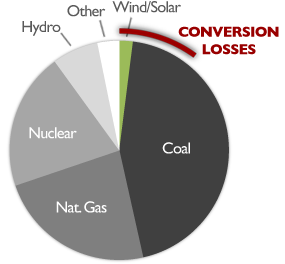Feb
28
Save That Alternating Electric Current
February 28, 2011 | 2 Comments
From the power plant to the computer you’re using the electricity is coming as alternating current (AC) – electrons going back and forth at either 50 or 60 reversals per second. It’s the best way today to move electricity over long distances. Almost all generation is done with an alternating generator, so right up to the back of the computer its alternating current.
Inside the computer is an inverter that converts the AC into direct current (DC) because the electronics need a steady and – one-way – flow of electrons to function. Imagine what a transistor would do if exposed to electrons going back and forth, it would simply not work, overheat and likely catch on fire. For now, until super conducting DC lines are cheaper than AC, its AC over distance and DC in the electronics.
Converting AC doesn’t come for free. The very best computer power supplies might get close to 90% efficiency, most are closer to 80% and the cheap stuff even less. The electrical load for all electronic devices, TVs, and many others with small inverting power supplies, even all those battery charges and power blocks as a share of the total electrical load is significant. Conversion is also a loss when working DC such as from a photovoltaic installation back to the grid.
Transphorm, a Southern California startup says it has technology providing a 90 percent improvement in the efficiency of converting between alternating current to direct current electricity. That would improve that computer power supply from 85% to 93.5% – if the math the company uses is stated correctly.
Transphorm predicted last week at a heavily attended media event at Google’s Mountain View headquarters that its electrical technology could ultimately save 10 percent of the nation’s total power consumption. That is the rough equivalent of more than 300 coal-fired power plants or the West Coast’s share of the nation’s total electrical consumption.
This is not an insignificant part of powering a nation. There is likely about 20% loss over all those conversions to DC across the national equipment inventory. Cutting than can really pay off.
Umesh Mishra, CEO of Transphorm bluntly puts it, “What everyone is doing is paying a hidden tax because of the inefficiency of power conversion.”
Transphorm’s technology is based on gallium nitride instead of widely abundant silicon. Gallium nitride (GaN) must be artificially manufactured, the basis for Transphorm’s technology. Mishra says, “it is a miracle material for power conversion” that can make the electrical grids of the U.S. and the developing world dramatically more efficient over the next 20 to 25 years. We’ll see, with venture capital backing and 30 patents in hand the likely hood is the pricing will be for what the market can bear instead of driving to the lowest possible cost and highest sales volume.
While this writer’s skepticism in based more on the business model born in a venture capital scenario instead hard-nosed business strategy, some technical experts wonder about the technology. The lost energy in an AC to DC conversion typically results in heat; meaning electrical facilities such as a large data center must use even more energy for cooling the equipment. So they caution Transphorm’s technology remains unproven, for now.
Steve Greenberg, an energy management engineer at the Lawrence Berkeley National Laboratory quoted in the MercuryNews says succinctly, “There is theoretically room for improvement and hopefully this will help us get there, but can I say that it will? No I’m always skeptical of announcements that are touting the greatest thing since sliced bread. It’s like, let’s see the numbers.” That’s right, both the working numbers and the financial numbers. It’s got to be cheap enough that that Chinese manufacturers of all those converters, power supplies and black power bricks sign on – or the technology is well, worth lots less.
Transphorm has received a $2.95 million grant from the federal government’s Advanced Research Projects Agency-Energy, which funds research in advanced energy technology.
Transphorm plans to unveil its first products at an energy conference in Texas in March. Mishra explains the company initially plans to focus on power conversion for power-hungry data centers. One wonders if the UL Lab has its test units yet.
The first pricing warning has been shot, with – if all things go as expected, automobile manufacturers, computer makers, photovoltaic manufacturers and other companies that make products that convert between AC and DC power who could use the startup’s technology, driving down the initially higher cost of gallium nitride technology. Just how much higher cost isn’t stated, and keep in mind, getting those silicone parts made is pretty sophisticated foundry work, which has driven to the lowest cost and the highest volume.
Randy Komisar, a partner with Kleiner Perkins, apparently speaking about $20 million in a third round of funding led by Google Ventures, Kleiner Perkins Caufield & Byers, Foundation Capital and Lux Capital, bringing Transphorm’s total venture funding to $38 million says, Transphorm “is not just a better, faster cheaper enterprise. It is a brave new world enterprise.” One wonders if the leaders understand how massive, diverse and widespread the converter market is.
It’s a lot of money on a material and some circuitry innovations. Lets hope management and investors are smart enough and the business model shrewd enough that the technology can be adopted en mass at low cost. There might be a whole lot of licensing going on – or not.
Comments
2 Comments so far



Save That Alternating Electric Current…
[…]February 28, 2011 | Leave a Comment. From the power plant to the computer you're using the electricity is[…]…
Great Save That Alternating Electric Current love it . I will pass it on to others Keep up the good content, Blogger, very interesting.